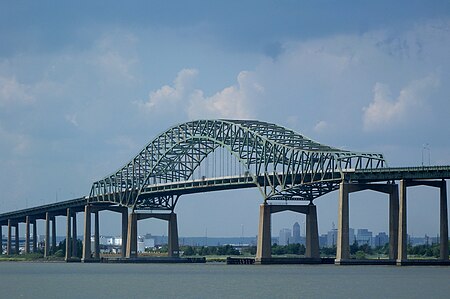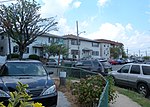Newark Bay Bridge

The Newark Bay Bridge, officially the Vincent R. Casciano Memorial Bridge, is a steel through arch bridge that is continuous across three spans. It crosses Newark Bay and connects the cities of Newark (in Essex County) and Bayonne (in Hudson County) in New Jersey, United States. It was completed April 4, 1956, as part of the New Jersey Turnpike's Newark Bay (Hudson County) Extension, with a ribbon-cutting ceremony led by Governor of New Jersey Robert B. Meyner.The main span is 1,270 feet (390 m), with a 135-foot (41 m) clearance over water to allow marine access to Port Newark. The bridge is similar in design to the Delaware River–Turnpike Toll Bridge, and is similar in length to the Francis Scott Key Bridge at Baltimore's Outer Harbor. It runs parallel to the earlier built Lehigh Valley Terminal Railway's Upper Bay Bridge. This bridge is also known as "The Turnpike Bridge" and "The Turnpike Extension Bridge". It carries traffic on a toll regulated section of Interstate 78 along the New Jersey Turnpike to interchanges 14 through 14A. It provides access from the New Jersey Turnpike's main roadway to Hudson County, New Jersey and the Holland Tunnel. The turnpike route creates the border between Bayonne and Jersey City and then runs northward along Port Jersey, Liberty State Park, and Downtown Jersey City. Hoboken is just north of the entrance to Holland Tunnel which continues to Lower Manhattan in New York City. From March 2014 until May 2019, during certain hours, the eastbound shoulder of the Turnpike Extension (including the bridge) was opened for normal traffic (by green arrows above, instead of red Xs), for a total of 5 lanes (3 eastbound, 2 westbound). This system was discontinued on May 20, 2019.There is a long-term capital improvements project to build a new bridge.
Excerpt from the Wikipedia article Newark Bay Bridge (License: CC BY-SA 3.0, Authors, Images).Newark Bay Bridge
East Port Street, Newark
Geographical coordinates (GPS) Address Nearby Places Show on map
Geographical coordinates (GPS)
| Latitude | Longitude |
|---|---|
| N 40.6953 ° | E -74.1184 ° |
Address
Vincent R. Casciano Memorial Bridge (Newark Bay Bridge)
East Port Street
07002 Newark
New Jersey, United States
Open on Google Maps









